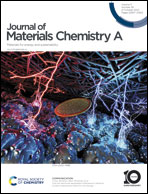On the quantification of hydrogen in lithium metal oxides†
Abstract
Hydrogen incorporation during crystal growth or other treatment has attracted research interest for a long time, but inconsistent literature data exist about the bulk hydrogen concentration in the lithium metal oxides LiMO3 with M = Nb and Ta. Hydrogen binds to oxygen and forms hydroxyl groups (OH−), which can be easily detected optically by FT-IR spectroscopy. However, this method cannot determine an absolute hydrogen concentration. With a reliably characterised concentration reference, a calibration for the fast and non-destructive FT-IR spectroscopy could be obtained. In this study, the hydrogen contents of as-grown and hydrogen-doped congruent and near-stoichiometric LiMO3 crystals were investigated by elastic recoil detection analysis (ERDA), carrier gas hot extraction (CGHE), 1H magic angle spinning nuclear magnetic resonance (1H MAS NMR) and hydrogen microscopy via proton–proton (p–p) scattering. However, not every method is suitable for the investigation of hydrogen in the LiMO3 host lattices. Based on p–p scattering, the A/cH calibration factors for FT-IR spectroscopy can be specified with (4.52 ± 0.58) × 10−17 cm and (6.46 ± 0.96) × 10−17 cm for LiNbO3 and LiTaO3, respectively.

- This article is part of the themed collection: #MyFirstJMCA


 Please wait while we load your content...
Please wait while we load your content...